June 2018 | VOL. 17, NO. 6| www.McGowan.pitt.edu
Dr. Steven Little Receives International Young Investigator Award for Development of Novel Drug Delivery Systems
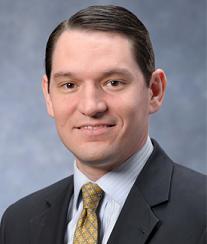
The Controlled Release Society has announced that McGowan Institute for Regenerative Medicine faculty member and University of Pittsburgh professor Steven Little, PhD, is the recipient of its 2018 Young Investigator Award. The honor annually recognizes one individual in the world, 40 years of age or younger, for outstanding contributions to the science of controlled release. Dr. Little is the William Kepler Whiteford Endowed Professor and Chair of the Department of Chemical and Petroleum Engineering at Pitt’s Swanson School of Engineering.
Dr. Little’s lab focuses on novel drug delivery systems that mimic the body’s own mechanisms of healing and resolving inflammation. This allows for dosages that are millions of times smaller than current medicine, and his next-generation treatments have shown promise for addressing a number of conditions including glaucoma, periodontal disease, wound healing, cancer, skin allergic dermatitis, and even transplantation of tissues and limbs. New “controlled release” systems developed by Dr. Little are applied once and then released over a period of days or months, depending on the medication.
His controlled release discoveries resulted in the co-founding of Pittsburgh-based Qrono Inc., which provides custom designed controlled release formulations for academic laboratories and agricultural and pharmaceutical companies.
More About Dr. Little
Dr. Steven Little is a William Kepler Whiteford Endowed Professor of Chemical and Petroleum Engineering, Bioengineering, Pharmaceutical Sciences, Immunology, Ophthalmology and the McGowan Institute for Regenerative Medicine at the University of Pittsburgh. He received his PhD in Chemical Engineering from Massachusetts Institute of Technology (MIT) in 2005, with his dissertation was the winner of the American Association for Advancement of Science’s Excellence in Research Award.
Researchers in Dr. Little’s Lab focus upon therapies that are biomimetic and replicate the biological function and interactions of living entities using synthetic systems. Areas of study include bioengineering, chemistry, chemical engineering, ophthalmology, and immunology, and the health issues addressed include autoimmune disease, battlefield wounds, cancer, HIV, ocular diseases, and transplantation. Dr. Little currently has 10 provisional, 2 pending, and 5 issued patents.
Dr. Little has been recognized by national and international awards including the Curtis W. McGraw Research Award from the American Society for Engineering Education (ASEE), being elected as a fellow of the Biomedical Engineering Society (BMES) and the American Institute for Medical and Biological Engineering (AIMBE), a Carnegie Science Award for Research, the Society for Biomaterials’ Young Investigator Award, the University of Pittsburgh’s Chancellor’s Distinguished Research Award, being named a Camille Dreyfus Teacher Scholar, being named an Arnold and Mabel Beckman Young Investigator, and being elected to the Board of Directors of the Society for Biomaterials. In addition, Dr. Little’s exceptional teaching and leadership in education have also been recognized by both the University of Pittsburgh’s Chancellor’s Distinguished Teaching Award and a 2nd Carnegie Science Award for Post-Secondary Education. Dr. Little was also recently named one of Pittsburgh Magazine’s 40 under 40, a “Fast Tracker” by the Pittsburgh Business Times, and also one of only five individuals in Pittsburgh who are “reshaping our world” by Pop City Media.
Congratulations, Dr. Little!
RESOURCES AT THE MCGOWAN INSTITUTE
July Histology Special
Mucins are a family of high molecular weight, heavily glycosylated proteins (glycoconjugates) produced by epithelial tissues in most metazoans. Mucins’ key characteristics include their ability to form gels; therefore, they are a key component in most gel-like secretions, serving functions that range from lubrication to cell signaling to forming chemical barriers. For example, mucin’s often serve a modulatory role by controlling mineralization and bone formation in vertebrates. Mucins bind to pathogens as part of the immune system, and overexpression of mucin proteins, especially MUC1, is associated with many types of cancer.
Alcian Blue / PAS
The combination of the alcian blue and various PAS techniques can be used to distinguish neutral mucins from acid mucins. In most protocols, sections are stained with the standard alcian blue (pH 2.5) method followed by the PAS technique. The alcian blue at a pH of 2.5 will stain all acid mucins deep blue but will not color the neutral mucins. The subsequent application of the PAS technique will stain the neutral mucins bright magenta. Tissues or cells that contain both neutral and acidic mucins may show a dark blue or purple coloration. The combined application of alcian blue and PAS is useful for several reasons. Changes in the distribution or pattern of expression of neutral and acid mucins are indicative of certain pathological conditions. In addition, the combined alcian blue/PAS technique is perhaps the most sensitive or comprehensive means for detection since all mucins should react regardless of the charge nature of the mucin.
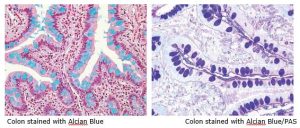
You will receive 30% off your Alcian Blue or PAS staining, or both, when you mention this article any time in July. Contact Lori at the McGowan Core Histology Lab and ask about our staining specials. Email perezl@upmc.edu or call 412-624-5265.
As always, you will receive the highest quality histology in the lowest amount of time.
Did you know the more samples you submit to the histology lab the less you pay per sample? Contact Lori to find out how!
UPCOMING EVENTS
7th Annual Internal Symposium on Regenerative Rehabilitation Symposium
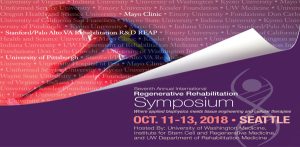
The Symposium on Regenerative Rehabilitation is the largest medical and scientific conference specific to Regenerative Rehabilitation in the world, bringing together two disparate disciplines, regenerative medicine and rehabilitative research, into one synergistic field of science. Innovative ideas, concepts and technologies were shared, deliberated and debated at this premier event. This new and innovative approach combines discoveries in tissue engineering and cellular therapies with rehabilitative treatments, resulting in improved functional outcomes for patients. This Symposium encourages the participation of scientists, clinicians and physical therapists who are in the fields of regeneration, physical medicine and rehabilitation. The Symposium agenda is designed to create a platform for bridging these areas of expertise in a setting that fosters discussion, interaction, cross-discipline pollination and networking.
The Symposium will be held October 11-13, 2018 in Seattle, Washington.
SCIENTIFIC ADVANCES
Comparing Risks and Costs for Biopsies in Women with Post-Menopausal Bleeding
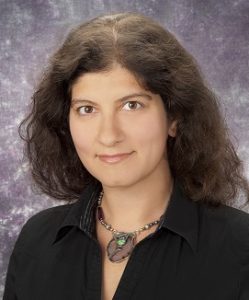
When it comes to diagnosing suspected endometrial cancer and several other endometrial pathologies in post-menopausal women, physicians in the U.S. have two choices: Pipelle biopsy, a minimally invasive procedure that has a 60 to 80 percent chance of success, or a more expensive, riskier procedure that works nearly every time called dilation and curettage (D&C).
In the first U.S. study to directly compare the clinical and economic consequences of the two procedures, University of Pittsburgh School of Medicine researchers have determined that it’s generally best to try the less-invasive route first – even if it means that some women will have to undergo the riskier procedure later. The results are reported in Gynecologic Oncology.
“Most women don’t want to go through an unnecessary procedure, experience health risks, take time off work or find transportation from the hospital,” said McGowan Institute for Regenerative Medicine affiliated faculty member Faina Linkov, PhD, MPH, who led the study and is an associate professor of obstetrics, gynecology and reproductive sciences at the Pitt School of Medicine. “So, we’re pleased to determine that the more convenient procedure can often be the best first choice for many women.”
Both Pipelle and D&C are widely used in the U.S. to diagnose endometrial cancer, the most common gynecologic cancer in post-menopausal women. Every year, an estimated 2 million women will reach menopause and about 10 percent will experience abnormal vaginal bleeding, which can be a symptom of cancer, its precursor or another gynecologic disease that needs to be addressed. To make an accurate diagnosis, tissue samples are taken in a doctor’s office during a Pipelle procedure, or they may be taken in the operating room during a D&C, which requires the use of general anesthetics.
Although the Pipelle procedure is lower risk, in up to 42 percent of post-menopausal women, especially for those with obesity, physicians are unable to access the uterine cavity or obtain adequate tissue samples. By contrast, physicians are able to obtain sufficient tissues samples during a D&C in close to 99 percent of procedures.
Using Medicare data for reimbursements in 2017, Dr. Linkov and her team analyzed the treatment of older women with post-menopausal bleeding. They found that the Pipelle procedure was equally effective and less costly than D&C, even considering the failure of the Pipelle procedure to consistently obtain access or adequate uterine tissue samples. The average Medicare reimbursement across the U.S. in 2017 for the Pipelle procedure was $244 and $2,310 for D&C.
“We don’t want to do a Pipelle in 100 percent of women, but only in women who are good candidates. For those women, we hope to maximize the number of Pipelles done in doctor’s offices, which will help minimize the number of D&C’s that must be done in operating rooms,” said Dr. Linkov. “Even if it’s not successful in some patients, our research shows that Pipelle should be used first in most women.”
Dr. Stephen Badylak at the World Advanced Therapies & Regenerative Medicine Congress
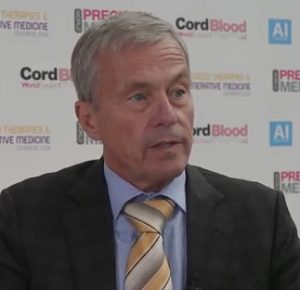
McGowan Institute for Regenerative Medicine Deputy Director Stephen Badylak, DVM, PhD, MD, Professor of Surgery and Director of the Center for Pre-Clinical Tissue Engineering within the Institute, was the Keynote Speaker at the World Advanced Therapies & Regenerative Medicine Congress (WATRMC), May 16-18, London, United Kingdom.
His presentation, “The Transformation and Clinical Translation of Regenerative Medicine,” touched on lessons learned from failed early stem cell therapy and tissue engineering, the role of the immune system in tissue/organ development, homeostasis, response to injury and regeneration, and the role of nanovesicles in functional tissue reconstruction.
Dr. Badylak also participated in an interview with Ian McKay of WATRMC. During the conversation, Dr. Badylak highlighted the structure and work of the McGowan Institute, how he entered the field of regenerative medicine, the history of tissue engineering, what is happening now in the clinic with regenerative medicine, and the current and future challenges to be solved. Listen to the interview here.
Illustration: WATRMC.
Exploiting Cellular and Molecular Mechanisms of Neuroinflammation for New Treatments of Chronic Pain
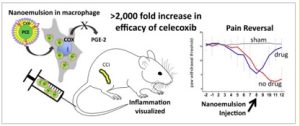
Can nanomedicine play a role in the future of pain treatment? Several answers to this question were presented during the American Pain Society Scientific Summit in Anaheim, California, earlier this year. McGowan Institute for Regenerative Medicine affiliated faculty member Jelena Janjic, PhD, Associate Professor of Pharmaceutics in the Graduate School of Pharmaceutical Sciences and Mylan School of Pharmacy at Duquesne University and the Founder and Co-Director of the Chronic Pain Research Consortium at Duquesne, provided one solution through her work on targeted nanomedicine for chronic pain treatment.
As reported by Ashley Cowie for the Pain Research Form, Dr. Janjic said that nanomedicine promises to improve drug delivery for pain treatment—
- by decreasing the amount of drug needed to alleviate pain
- by enabling treatment adjustment as the patient recovers
- by offering the potential to release drugs upon disease flare-ups, and
- by targeting drugs only to specific tissues.
Dr. Janjic has designed a new Theranostic Analgesic Regenerative Gel-Emulsion Technology (TARGET) platform for localized delivery of an anti-inflammatory drug to the site of injury. TARGET works by incorporating a nanoemulsion containing a drug into a gel, which helps promote extended drug release at the site of injury. The newly developed TARGET platform is being evaluated for safety, feasibility, and efficacy in experimental pain models at the research facilities of the 59th Medical Wing of the United States Air Force.
As part of this collaborative project, Dr. Janjic and McGowan Institute affiliated faculty member John Pollock, PhD, Professor of Biological Science at Duquesne University, delivered the nanoemulsion via tail vein injection into rats eight days after they underwent chronic constriction injury (CCI), a model of neuropathic pain. These animals displayed significantly less mechanical hypersensitivity compared to rats that received a nanoemulsion containing no drug. Measurement of inflammation using NIRF labeling of macrophages that had engulfed the nanoemulsions without the drug revealed heightened fluorescence over the injured sciatic nerve, which was significantly decreased in animals that received the drug-containing nanoemulsion. This suggested that the macrophages containing celecoxib were most likely not of the inflammatory phenotype and did not migrate to the site of injury.
Next, the researchers studied the effects of the nanoemulsions on the number of infiltrating monocyte-derived macrophages, COX-2 expression, and PGE2 expression in the injured sciatic nerve using immunofluorescence. Treatment with celecoxib-containing nanoemulsions significantly reduced all three, compared to treatment with nanoemulsions without the drug.
In summary, nanoemulsion therapy significantly reduced inflammation at the site of injury, which coincided with decreased pain hypersensitivity. This holds promise for future therapies to utilize nanomedicine, allowing for low-dose, targeted drug delivery that avoids damage to healthy tissues.
Illustration: Journal of Neuroimmunology.
Dr. Jessie VanSwearingen: Aging and Fall Prevention
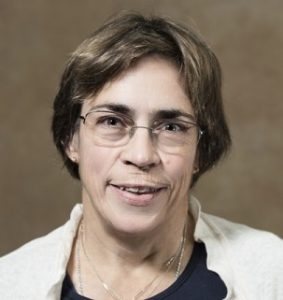
As reported by Gary Rotstein, Pittsburgh Post-Gazette, the CDC says about one of every four older adults falls in a year. In 2016 those resulted in 29,668 deaths, and the mortality rate attached to such falls has been increasing about 3 percent annually.
Recently, Mr. Rotstein interviewed McGowan Institute for Regenerative Medicine affiliated faculty member Jessie VanSwearingen, PhD, PT, FAPTA, regarding her 20 years of research focused on older adults’ mobility and falls prevention issues. In the interview, Dr. VanSwearingen explains why older people fall with such frequency, when they didn’t do so earlier in adulthood. She also addresses the right steps people can take to avoid falling in the first place and how doctors and family members or caregivers can help. Read the entire interview here.
Dr. VanSwearingen is an Associate Professor in Physical Therapy in the University of Pittsburgh’s School of Health and Rehabilitation Sciences and holds a joint appointment within the School of Nursing. Dr. VanSwearingen received her PhD in Anatomy and Cell Science from the Department of Neurobiology within Pitt’s School of Medicine. Professionally, Dr. VanSwearingen has fostered interests in several areas of her field, including:
- Geriatrics, movement control and neuromotor function
- Facial neuromuscular disorders
- Physiological basis for exercise in health, repair, and recovery of function
Illustration: University of Pittsburgh’s School of Health and Rehabilitation Sciences.
Successful Vision Restoration to Strengthen with Modern Medicine
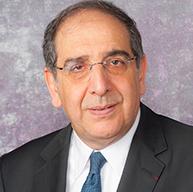
In the world of ophthalmology, researchers have always made vision restoration by retinal repair their goal. Today, this goal is more obtainable than ever through modern technologies and medical practices, and the first successful procedures have already taken place.
With this dream of full vision restoration in mind, Botond Roska, MD, PhD, senior group leader of the Friedrich Miescher Institute for Biomedical Research in Switzerland, and José-Alain Sahel, MD, director of the UPMC Eye Center, have pinpointed the current state of vision repair and the roadblocks that have gotten in the way of success, as well as potential new therapies that might be available in the future in their article, “Restoring Vision,” published recently in the journal Nature.
Regardless of medical advancements, part of what makes treating blindness by retinal repair so difficult, according to Drs. Roska and Sahel, is that the retina is a complex part of the brain. The retina is at the back of the eyeball and contains cells that are sensitive to light and, through the optic nerve, communicate an image to the brain.
“Apart from these major developments in therapies and in our understanding, advances in clinical care to treat blinding diseases have perhaps been slow from the point of view of the patient,” Dr. Roska and Sahel said in their article.
With time and research, the retina has become more manageable, prompting the authors to propose four new medical technology models that might make vision restoration a possibility:
- Gene therapy: This treatment has been made possible through the ability of the adeno-associated virus (AAV) to deliver genes to retinal cells.
- Cell therapy: This treatment provides retinal repair via ectopic cell transplantation to replace damaged or dead cells, but it is still experimental.
- Induced retinal regeneration: This treatment was inspired by certain animals who automatically regenerate their retinal cells. Humans and other mammals are not capable of this regeneration but, in the future, it could become a possibility.
- Artificial retinal stimulation: This treatment involves the patient wearing a camera on their glasses that would be connected to an electronic implant, stimulating the retina and other areas of the eye through light activation to allow the patient to see an image. Higher-resolution electronic implants are currently being developed, and Drs. Roska and Sahel predict artificial stimulation will be an integral part of vision restoration in the future.
While any of these technology models could potentially be used to treat several variations of vision-related diseases, what makes effective treatment difficult is determining which model is appropriate to use for which case. Drs. Roska and Sahel said it depends on whether the patient is blind or partially blind.
“If the patient is fully blind, the goal of treatment is vision restoration, even partial,” Dr. Sahel said. “If the patient is visually impaired with some vision remaining, prevention of additional vision loss is the goal. This can make treatment development difficult, as we don’t want to further damage the vision through a treatment with possible safety concerns.”
Also, due to the complexity of each patient and each retina, Drs. Roska and Sahel said each patient should be treated as an individual to increase chances of vision restoration, opposed to a one-size-fits-all treatment.
“Therefore, we argue that both the diagnosis and the treatment of retinal diseases should be cell-type focused; disease by disease,” they said.
Infection Blood Test of Limited Value in Reducing Antibiotic Use

Overall antibiotic use was not curbed by giving physicians the results of biomarker tests in patients with suspected lower respiratory tract infections, according to findings from the Procalcitonin Antibiotic Consensus Trial (ProACT). The national, randomized clinical trial was coordinated by researchers at the University of Pittsburgh School of Medicine, and funded by the National Institute of General Medical Sciences, part of the National Institutes of Health (NIH). The results, published recently in the New England Journal of Medicine, were presented at the ATS 2018 International Conference in San Diego. McGowan Institute for Regenerative Medicine affiliated faculty members Derek Angus, MD, MPH, and John Kellum, MD, are co-authors on the study.
The overuse of antibiotics has become a serious threat to global public health, causing antibiotic resistance and increasing health care costs. Physicians have long known that antibiotics are usually unnecessary for acute bronchitis and for some other cases of lower respiratory tract infections, and that antibiotics treat only bacterial infections, not viral.
“But in daily practice, many physicians often prescribe them,” said lead author David Huang, MD, MPH, associate professor in Pitt’s departments of Critical Care Medicine and Emergency Medicine, and director of the Multidisciplinary Acute Care Research Organization (MACRO) Center, and the Clinical Research, Investigation, and Systems Modeling of Acute Illness (CRISMA) Center’s administrative core.
Previous research had reported that using a biomarker blood test and following an antibiotic guideline tied to the test results could reduce antibiotic use in lower respiratory tract infections. In February 2017, the U.S. Food and Drug Administration approved the biomarker test that measures procalcitonin – a peptide that typically increases in bacterial infections, but not viral.
The ProACT trial involved 14 predominately urban academic hospitals. Researchers enrolled 1,656 adult patients who presented to the hospital emergency department and were initially diagnosed with a lower respiratory tract infection. All the patients were tested for their procalcitonin levels, but the results were shared only with the physicians of the patients randomly assigned to procalcitonin-guided antibiotic prescription.
In contrast to previous research, the ProACT trial showed that the procalcitonin guideline had little overall impact on whether or not the physicians prescribed antibiotics, although in patients with acute bronchitis, antibiotic prescription in the emergency department was cut in half in patients whose physicians were provided the procalcitonin guideline. Huang noted, however, that the finding for acute bronchitis was a secondary analysis.
The exact reasons why the results of this recent research contrast with previous studies are unclear, but the ProACT team found that procalcitonin test results generally matched up with how sick a patient looked as well as their physician’s judgment on how likely it was they had a bacterial infection. The team also found that even when physicians did not know their patient’s procalcitonin result, their decision to prescribe antibiotics was generally the same as when physicians did know the result.
“In other words, it seems likely that physicians already commonly withheld antibiotics based on clinical signs alone, and, therefore, instead of the magic bullet I and many others hoped procalcitonin might be, it offered only limited incremental value over clinical judgment,” said Dr. Huang.
Antibiotic overuse also has received increased attention since the last large trial of procalcitonin and lower respiratory tract infection was completed 10 years ago. Improved prescribing practices may have reduced the chance of the procalcitonin biomarker further decreasing antibiotic use, Dr. Huang said.
“I hope our results will help physicians decide when to order procalcitonin and will encourage future research and randomized trials to determine the clinical utility of other novel biomarkers and diagnostic tests in general,” Dr. Huang said.
Study: Most Concussion Patients Fall Under the Radar
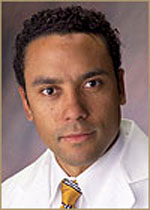
More than half of patients hospitalized for a concussion receive no follow-up care within three months of their discharge, according to a national multi-center study published recently. McGowan Institute for Regenerative Medicine affiliated faculty member David Okonkwo, MD, PhD, is a co-author on the study. Dr. Okonkwo is Professor and Executive Vice Chair of Neurological Surgery, University of Pittsburgh, with a secondary appointment as Professor of Sports Medicine and Nutrition. He serves as Director of Neurotrauma and of the Scoliosis and Spinal Deformity Program at UPMC. In addition, he is the Clinical Director of the Brain Trauma Research Center. Dr. Okonkwo is also a member of the Medical Staff for the Pittsburgh Steelers.
Millions of Americans suffer concussions each year, and many endure symptoms for months or years afterward. But a study of 831 patients sent to top-level trauma centers for a concussion or mild traumatic brain injury (mTBI) found that only 44 percent saw a physician or other provider within three months of their injury, a critical period for care. In addition, only 47 percent received educational materials about their injury before they went home.
“The lack of follow-up after a concussion is concerning because these patients can suffer adverse and debilitating effects for a very long time,” said Seth Seabury, PhD, a lead author of the study and director of the Keck-Schaeffer Initiative for Population Health Policy at the USC Schaeffer Center for Health Policy and Economics. “Even patients who reported experiencing significant post-concussive symptoms often failed to see a provider. This reflects a lack of awareness, among patients and providers, that their symptoms may be connected to their brain injury.”
Dr. Okonkwo told Marie Fazio of the Pittsburgh Post-Gazette that the lack of follow-up care and education involving minor traumatic brain injuries (mTBIs) is a “massive public health epidemic.”
“One of the goals of this study is to better understand the public health implications and identify gaps in clinical care so we can do a better job of treating patients.
“This study should be a siren call to the National Institutes of Health and other federal agencies about the tremendous gap between the public health need and the public health resources that are devoted,” said Dr. Okonkwo.
The study was published by JAMA Network Open. Data came from the ongoing Transforming Research and Clinical Knowledge in Traumatic Brain Injury study, or TRACK-TBI. Supported by the National Institute of Neurological Disorders and Stroke, the TRACK-TBI study has collected detailed information, including CT/MRI imaging, blood bio-specimens and detailed clinical outcomes, for more than 2,700 brain injury patients from 18 different U.S. sites.
“For too many patients, concussion is being treated as a minor injury,” said Geoffrey Manley, MD, PhD, principal investigator of the TRACK-TBI project and co-author on the study. “This is a public health crisis that is being overlooked.
“If physicians did not follow up on patients in the emergency department with diabetes and heart disease, there would be accusations of malpractice,” added Dr. Manley, a neurosurgeon at the University of California, San Francisco (UCSF).
“The study shows that we need to give patients and doctors the tools to better identify who should be going in for follow-up care,” Dr. Seabury said.
Pittsburgh medical centers, including UPMC Sports Medicine, Rehabilitation Medicine and Neurosurgery divisions have been ahead of the curve in severe head injuries for years, Dr. Okonkwo said.
“This study opens the door to a much stronger conversation about how to have the quality of care in the Pittsburgh region spread to other areas of the United States,” he said.
Restoring Identities With DBS
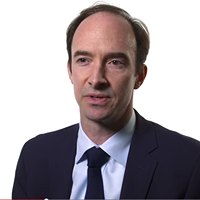
Deep brain stimulation (DBS) at UPMC has proven to be an effective treatment for involuntary movements associated with Parkinson’s disease and epilepsy, such as tremors, slowness of movement, rigidity, and problems with walking and balance. DBS is also approved for obsessive-compulsive disorder (OCD) treatment under a Humanitarian Device Exemption.
McGowan Institute for Regenerative Medicine affiliated faculty member R. Mark Richardson, MD, PhD, is an Assistant Professor, Department of Neurological Surgery, University of Pittsburgh. At Pitt, Dr. Richardson is also the Director, Brain Modulation Laboratory, and the Director, Epilepsy and Movement Disorders Surgery Program, both in the Department of Neurological Surgery. Dr. Richardson calls DBS the “gold standard” for treating patients with Parkinson’s disease and for those with essential tremor, the most common type of tremor mainly found in people over age 65. An essential tremor is not dangerous or life-threatening, but it can be annoying and embarrassing for many people.
In the Summer 2018 issue of PittMed, Gavin Jenkins reports several of Dr. Richardson’s patients’ experiences before and after DBS—one with Parkinson’s disease and one with an essential tremor—and others involved with testing DBS for other potential clinical uses. Dr. Richardson has performed more than 300 DBS surgeries in seven years at Pitt. DBS is designed to be reversible. It’s more targeted than current interventions that bathe the brain and the rest of the body in chemicals.
Yet, he understands why there are hesitations about the procedure. He’s implanting foreign objects into a brain, placing a pacemaker-like battery into the chest, and connecting it all with a wire under the skin. Do we know enough about the brain to fiddle with it in this way? Can DBS somehow change who these patients are?
“The counterargument is,” Dr. Richardson says, “that we’re trying to restore these people’s identity.”
Deep brain stimulation is a surgical procedure in which a hair-thin wire (electrode) is implanted in the area of the brain that is responsible for abnormal movement. The wire is connected to a pulse generator that is implanted under the skin below the collarbone. Once activated, the generator sends mild electrical pulses through the wire to the brain. These electrical pulses modify the brain’s electrical signals to help control or stop abnormal movements.
Deep brain stimulation is both adjustable and reversible. New technology allows patients to use a remote control to adjust the level of stimulation needed to provide the greatest symptom relief with the least amount of side effects.
Patients who received deep brain stimulation have shown:
- Symptoms lessen by 40 to 60 percent
- Improved quality of life
- Increased independence
The most profound DBS issue for Dr. Richardson: So few patients who qualify for the help actually get the procedure. Medical-device makers estimate that only 10 to 13 percent of eligible Parkinson’s patients receive the surgery.
Physiologically Based Pharmacokinetic Model Predicts Changes in BUP Exposure at Different Stages of Pregnancy
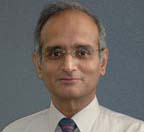
Buprenorphine (BUP) is approved for the treatment of opioid addiction. The current dosing regimen of BUP in pregnant women is based on recommendations designed for non-pregnant adults, but physiological changes during pregnancy may alter BUP exposure and efficacy.
As described in a British Journal of Clinical Pharmacology study, researchers—led by McGowan Institute for Regenerative Medicine affiliated faculty member Raman Venkataramanan, PhD—have developed a physiologically based pharmacokinetic model that predicts changes in BUP exposure at different stages of pregnancy. The model predicted a decrease in BUP exposure during pregnancy and demonstrated the need for an increase in dose or dosing frequency to maintain efficacy throughout pregnancy. This must be followed by a reduction in dose of buprenorphine after delivery.
“Modeling can help make predictions when it is difficult to get actual data in a patient population such as pregnant women with opiate addiction. Our predictions in fact agree with our clinical observations in a small number of patients published earlier. Lack of recognition of the impact of pregnancy on how the body handles drugs can cause therapeutic failure and may explain the high withdrawal rate of subjects on methadone / buprenorphine maintenance therapy for opioid addiction,” said senior author Dr. Venkataramanan, Professor of Pharmaceutical Sciences and Pathology at the University of Pittsburgh. In addition, he is the Director of the Clinical Pharmacokinetics Laboratory and the Associate Director of Therapeutic Drug Monitoring and Toxicology. Dr. Venkataramanan is also a Member of the Thomas E. Starzl Transplant Institute and the Magee Women’s Research Institute and a Professor in the University of Pittsburgh Cancer Institute and Pitt’s Department of Pharmacy and Therapeutics.
AWARDS AND RECOGNITION
Dr. David Vorp Named Fellow of the American Heart Association
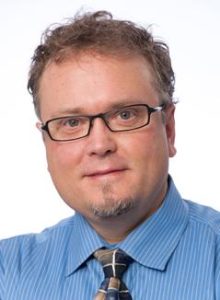
McGowan Institute for Regenerative Medicine affiliated faculty member David Vorp, PhD, Associate Dean for Research and John A. Swanson Professor of Bioengineering at the University of Pittsburgh Swanson School of Engineering, was named a Fellow of the American Heart Association (FAHA) in recognition of his innovative and sustained contributions in scholarship, education, and volunteer service to the organization. Dr. Vorp’s election was conferred by the Council on Arteriosclerosis, Thrombosis and Vascular Biology (ATVB) recognizing his work in those fields.
The ATVB is recognizing Dr. Vorp for his achievements in cardiovascular research over the past 26 years. He has published more than 120 peer-reviewed research articles and currently serves on three editorial boards. His research has been supported by over $14 million from the National Institutes of Health, the American Heart Association, and other sources. He has several patents in the field of vascular bioengineering and is a co-founder of Neograft Technologies, Inc., a startup that uses technology developed in his lab to help produce arterial vein grafts.
Dr. Vorp’s lab applies its strengths in computational and experimental biomechanics, image analysis, cellular and molecular biology, and tissue engineering to understand and seek solutions to pathologies of tubular tissue and organs. His current research aims to develop regenerative treatments for vascular diseases such as aortic aneurysm and coronary heart disease.
“Dr. Vorp has very effectively and creatively applied his unique expertise as a bioengineer to advance our understanding of the pathogenesis and treatment of several potentially lethal clinical problems, such as aortic aneurysms,” said Marshall Webster, MD, Senior Vice President of the University of Pittsburgh Medical Center. “He has mentored and promoted the careers of a new generation of bioengineers and has established our University as a world class research and training environment, widely recognized.”
Dr. Vorp has had 14 PhD students graduate from his lab and is currently advising two. He has supervised or mentored 10 medical students, 16 postdoctoral research associates and visiting scholars, and over 80 undergraduate students. Additionally, he has served on over 40 graduate student thesis committees.
Other organizations have recognized Dr. Vorp’s contributions to the field. He is an elected Fellow of the Biomedical Engineering Society (BMES), the American Institute for Medical and Biological Engineering (AIMBE), and the American Society of Mechanical Engineers (ASME). In 2012, he became the first non-MD President of the International Society for Applied Cardiovascular Biology and was re-elected for a second term in 2014. His other executive roles include his appointment as ASME Bioengineering Division Chair from 2013-2014, two terms on the BMES Board of Directors, and two terms as BMES Secretary.
Founded in 1924, the American Heart Association is the nation’s oldest and largest voluntary organization dedicated to fighting heart disease and stroke. They provide funding for innovative research, fight for stronger public health policies, and provide critical tools and information to save and improve lives.
Congratulations, Dr. Vorp!
Dr. Michael Boninger Awarded NYU Langone’s Rusk Leadership and Innovation Award
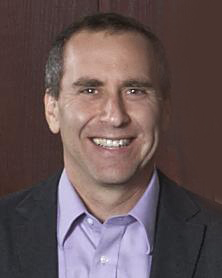
New York University (NYU) Langone Health’s Rusk Rehabilitation hosted its fourth annual research symposium recently featuring several renowned speakers, including McGowan Institute for Regenerative Medicine affiliated faculty member Michael Boninger, MD, Professor and UPMC Endowed Vice Chair for Research in the Department of Physical Medicine & Rehabilitation, School of Medicine, University of Pittsburgh. Dr. Boninger, a leader in shaping rehabilitation medicine’s role in the changing world of healthcare, is this year’s recipient of the Rusk Award for Leadership and Innovation in PM&R. Dr. Boninger received this award for his contributions for individuals with disabilities through the development of assistive, rehabilitative, and regenerative technologies.
Dr. Boninger holds joint appointments at Pitt in the Departments of Bioengineering and Rehabilitation Science and Technology. He is also a physician researcher for the United States Department of Veterans Affairs. He is Senior Medical Director for Post-Acute Care for the Health Services Division of UPMC and Vice President for Medical Affairs for UPMC Community Provider Services (CPS). CPS is the umbrella organization that oversees and manages all of UPMC’s clinical programs in community-based and post-acute settings. These programs include Home Health, Senior Communities and eldercare, speech, occupational and physical therapy, UPMC’s specialty, retail, infusion, and institutional pharmacy businesses, and Community Supportive Services programs.
Congratulations, Dr. Boninger!
Dr. Steven Belle Honored for Contributions to Clinical Trials
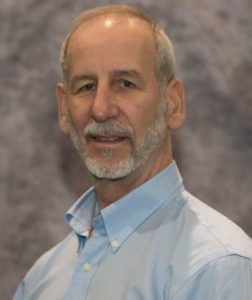
McGowan Institute for Regenerative Medicine affiliated faculty member Steven Belle, PhD, MScHyg, co-director of the Epidemiology Data Center at the University of Pittsburgh Graduate School of Public Health, has been named a Fellow of the Society for Clinical Trials, a prestigious honor that only a few scientists achieve each year.
Dr. Belle was recognized by the society for outstanding leadership of data coordinating centers for several multicenter studies of surgical outcomes and other treatment trials across a wide range of conditions and applications, including obesity and liver disease. He was also cited for his work combining information across multiple clinical trials.
“It’s an honor to be recognized by those who themselves are leaders in the premier international society devoted to clinical trials and other health care research,” Dr. Belle said. “I’ve been pleased to contribute to, and lead, data coordinating centers for clinical trials testing treatments for various conditions, including hepatitis C and pediatric acute liver failure, for surgical studies in obesity and liver transplantation, and to contribute to studies aimed at enhancing the health of people who care for those with Alzheimer’s disease.
“I would like to believe that all contributed to furthering knowledge and improving health and quality of life across the lifespan.”
The Society for Clinical Trials is a multidisciplinary organization with a mission of working internationally to advance health through advocating for the use of clinical trials, leading the development and dissemination of optimal methods and practices in clinical trials, and educating and developing clinical trial professionals.
An epidemiology professor with a secondary appointment in biostatistics at Pitt Public Health, Dr. Belle was one of five scientists awarded the status of Fellow at the Society for Clinical Trials’ recent annual meeting in Portland, Oregon.
Dr. Belle received his PhD in biostatistics from the University of Michigan and his Master of Science in Hygiene from Pitt. He joined Pitt Public Health in 1985. He has authored more than 150 publications and has been principal investigator for several data coordinating centers funded by the National Institutes of Health.
He also has developed and leads methodology courses in Pitt Public Health’s Department of Epidemiology and has mentored numerous graduate students.
In addition to the Society for Clinical Trials, Dr. Belle is a Fellow of the Gerontological Society of America and is an elected member of the Delta Omega Public Health Honor Society-Omicron Chapter.
Illustration: UPMC.
Dr. Rory Cooper Awarded American Institute for Biomedical Engineering Advocacy Award

McGowan Institute for Regenerative Medicine affiliated faculty member Rory Cooper, PhD, founding director and VA senior research career scientist of the Human Engineering Research Laboratories in Pitt’s School of Health and Rehabilitation Sciences, was awarded the American Institute for Biomedical Engineering’s 2018 Advocacy Award for outstanding and lasting contributions to humanity and the field of bioengineering.
The nomination, which cannot come from a home institution, noted the breakthrough devices that he helped to create to transform the lives of people with disabilities, and how his research and development exemplifies the highest qualities of bioengineering. Dr. Cooper’s work includes ground-breaking innovations in developing next generation assistive technology to promote independent living, upgraded rehabilitation practices and improved treatment guidelines for combat amputees.
The institute makes a maximum of three awards each year in advocacy, education and public policy. Dr. Cooper is the first person from Pitt to receive any of these awards.
Regenerative Medicine Podcast Update
The Regenerative Medicine Podcasts remain a popular web destination. Informative and entertaining, these are the most recent interviews:
#184 –– Dr. Jennifer Elisseeff is a professor of Ophthalmology and Biomedical Engineering at the Whiting School of Engineering and Johns Hopkins School of Medicine. Dr. Elisseeff discusses her work with the Journal of Immunology and Regenerative Medicine as well as her research in lost tissue repair.
Visit www.regenerativemedicinetoday.com to keep abreast of the new interviews.
PUBLICATION OF THE MONTH
Author: George S. Hussey, Jenna L. Dziki & Stephen F. Badylak
Title: Extracellular matrix-based materials for regenerative medicine
Summary: In tissue engineering and regenerative medicine, a biomaterial provides mechanical support and biochemical signals to encourage cell attachment and modulate cell behaviour. Nature’s template for a biomaterial is the extracellular matrix (ECM). The ECM contains intrinsic biochemical and mechanical cues that regulate cell phenotype and function in development, in homeostasis and in response to injury. The use of ECM-based materials in biomedical research has advanced from coating cell culture plates with purified ECM components to the design of ECM-mimicking biomaterials and the engineering of decellularized tissues aimed at recapitulating the dynamics, composition and structure of the ECM. In this Review, we highlight important matrix properties and functions in the context of tissue engineering and regenerative medicine, consider techniques such as proteomics for the investigation of matrix structure and composition and discuss different engineering strategies for the design of matrix-mimicking biomaterials. Tissue, whole organ and cell culture decellularization approaches are examined for their potential to preserve the tissue-specific biochemical composition and ultrastructure of the ECM and for the development of biomaterials that promote the formation of functional tissues in clinical applications. Finally, we investigate challenges and opportunities of ECM biomaterials for the design of organotypic models to study disease progression, for the ex vivo creation of engineered tissue and for the clinical translation of functional tissue reconstruction strategies in vivo.
Source: Nature Reviews Materials (29 May 2018)
GRANT OF THE MONTH
PI: Eric Lagasse
Title: A New Molecular Mechanism to Bioengineering a Liver
Description: Hepatocyte transplantation has many potential applications. Extensive animal experiments have shown that hepatocytes transplanted in the liver or at ectopic sites survive, function, and actively participate in the regenerative process. However, our understanding of hepatocyte engraftment and their remarkable proliferative and regenerative potential is limited, even if primary hepatocyte transplantation is at the doorstep of applications in the treatment of inherited and acquired human diseases. We previously made a serendipitous observation that normal hepatocytes transplanted in the peritoneal cavity of an animal with lethal liver disease migrate into the lymphatic system and engineer ectopic liver-like organoids that rescue an animal model from a fatal metabolic disorder. How hepatocytes enter the lymphatics and what molecular mechanism is responsible for the generation of ectopic mass is not known. We hypothesized that hepatocytes must borrow some of the molecular mechanism lymphocytes use to migrate into the lymphatics. Our interest will be to study ectopic cell transplantation and our central objective of our application is to translate a highly interesting observation, the generation of ectopic liver, to a potential clinical application for patients with liver diseases.
Source: National Institute of Diabetes and Digestive and Kidney Diseases
Amount: $419,339/year
Term: 1 April 2018 – 31 March 2023
